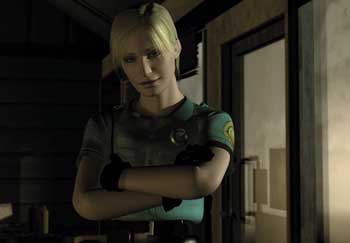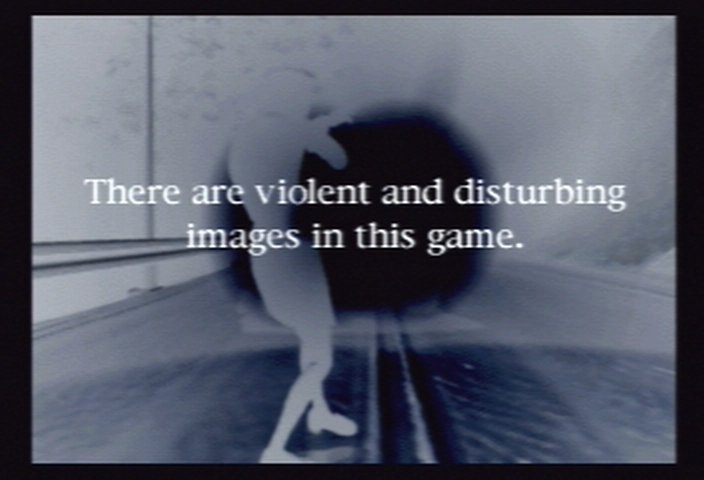Writer
Orson Scott Card once came up with a classification scheme for scary media
which works well in describing what sets Konami's Silent Hill apart from the
rest of the pack. Terror, says Card, is about being shocked at the monster
jumping out of the shadows, while dread is about being afraid of what might
be about to jump out of the shadows. Card further argues that dread is a more
powerful tool than terror, because while terror is focused entirely into one
cathartic moment, dread can be stretched out, and targeted against any number
of suspicious things. In the minds of many gamers, Silent Hill has proven Card's
hypothesis by making a game where the actual monsters in the dark aren't
nearly as scary as what a player thinks might be just beyond the range of
his flashlight, waiting.
| |

Your pitiful attempts at survival amuse me greatly
|
Silent Hill is a third person 3D adventure game that
generates immediate comparisons to Resident Evil and Parasite Eve with battles
against various monstrosities and horror film sensibilities. The plot revolves
around Harry Mason, a regular guy on vacation who loses his daughter and must
track her through the mostly deserted ruins of Silent Hill, a small resort town.
Like other games in the Resident Evil genre, Silent Hill is divided between
dispatching monsters with various weapons, solving puzzles to get through various
mazes, and figuring out what the hell is actually going on, with a bit of rendered
video thrown in for good measure.
But Silent Hill has its own unique take on the genre.
The most obvious is the game's dependence on atmosphere over mindless action or
dazzle. Environments in the town are shrouded in mist at best and plunged into
total darkness at worst, lit only by a small pool of illumination from a pocket
torch. Monsters rarely pop up out of nowhere, ready to fight, but instead stay
just out of visual range until they're ready to charge. How do you know they're
out there? Through one of the most eerie features ever implemented in a game - a
small radio that plays increasingly loud static as monsters approach. A good chunk
of a player's time will be spent staring into the dark, listening to white noise
and waiting for something to come screeching out of the rain. Silent Hill is full
of these little touches, from town streets named after horror writers to cries and
rattles coming from unknown locations to the word "REDRUM" scrawled on the side of
a liquor store.

No, really, they mean it |
|
Konami's even clever enough to make some of the game's
shortcomings into strengths. Like almost all Playstation games the 3D rendering
here is sometimes crude, but taken in Silent Hill's own context slightly warped
doors and blurry textures only serve to strengthen the atmosphere of dread. This
low resolution methodology is especially effective with monsters, who are almost
always glimpsed only in passing as vague shapes, and as a result become something
you might remember from your childhood nightmares. You'll want machine guns, grenades
and rocket launchers against these things, but through most of the game all you'll be
able to muster is a handgun with a limited amount of ammo, which leads to a mentality
that prefers flight to fight. (However, you can ultimately get a chainsaw and get
appropriately psychopathic.)
| |

Yes, and one with extra cheese. Thank you. |
Silent Hill's main deficiency is its own complexity.
The main game is relatively short, running only about 8 hours on the first
play though, but you won't half understand what's been happening. To see the
"best" endings players must perform certain actions that aren't documented or
explained at all in the game. This stands in strong contrast to most of the
dungeon puzzles, which are tricky but can be figured out with the available
clues, given enough time. Making the first play through more complex but completely
winnable would have made this title much stronger.

That's the last time my daughter gets to drive... |
|
Silent Hill's final notable feature can be a strength
or a weakness depending on your tastes - this game is dark, and in places
genuinely frightening. The short interactive introductory sequence, for example,
starts out empty and nicely spooky, but quickly descends into a sequence that
wouldn't be out of place in a Hellraiser movie. Much of the game follows the
same pattern, descending into darker and darker environments until a player
may be dreading playing more of the game as much as he dreads the monsters
in the darkness. To put it bluntly, Silent Hill is not a very fun game unless
you have a very odd sense of fun. This is not to say Silent Hill isn't worth
looking at - it's entirely possible to enjoy the game as an expertly done piece
of entertainment even if it doesn't create quite the same feeling of joy you
might get from playing Zelda 64. Also the game does get much more compelling
further in, as more of the backstory becomes uncovered and the grimness begins
to level off somewhat. Regardless of whatever else might be said about it, Silent
Hill is an extremely well done game by a skilled, experienced game producer. One
final piece of advice, though: if you do get into Silent Hill, try not to play at night.
Retrospective by Chris Jones, GIA. |
|
 |
 |
 |
 |
| Silent Hill |
| Developer |
KCET |
| Publisher |
Konami |
| Genre |
Survival Horror |
| Medium |
CD (1) |
| Platform |
PlayStation |
| Release
Date |

02.99 |

02.99 | |
| Information |
| Walkthrough, Street Name FAQ |
| Media |
| 225 violent and disturbing images |
| Artwork |
Other |
| Box art |
| |
 |
 |
 |
 |
 |
 | |
|






